Abstract
Sustainability study of the standard wastewater treatment system is the pivotal procedure in the water protection field. In order to better study the sustainability of sewage treatment systems, wastewater treatment system of straw pulp papermaking (WTSPP) and wastewater treatment system of printing and dyeing and papermaking (WTPDP) have been selected to assess the sustainable level in China. Based on the hybrid neural network and emergy framework, WTSPP and WTPDP were considered and analyzed in this paper. Therein, three types of indicators were used to evaluate these two systems, including basic structure emergy indicators (BEI), functional emergy indicators (FEI), and eco-efficiency emergy indicators (EEI). Through the basic neural network model and detailed neural network model design, the iteration paths and algorithm operation diagram of WTSPP and WTPDP were designed and realized in this article. Primary contents include: (1) For WTSPP and WTPDP, nonrenewable resources emergy are both the primary contributor and account for roughly 62.5% and 53.7%, respectively. (2) As the important indicator group, the environmental loading ratio (ELR) is 176 in the WTSPP and 323 in the WTPDP, respectively. Emergy sustainability indicators (ESIs) in the WTSPP and WTPDP, are 0.015 and 0.014, respectively. (3) Depending on fluctuation degrees, WTSPP is better than WTPDP. The maximum fluctuation ranges of WTSPP and WTPDP are (3%, −27%) and (28%, 61%), respectively. (4) All neural network analysis results manifest that the emergy sustainability indicators (ESIs) of WTSPP and WTPDP are [0.0151, 0.011] and [0.0179, 0.0055] in view of a long-term predictive view, respectively.
1. Introduction
With the rapid development of China’s economy, a large amount of sewage is discharged every year, causing severe environmental problems and drinking water safety. For example, 73.53 billion tons of wastewater was treated in 2015, such as 22.235 million tons of chemical oxygen demand (COD) and 2.299 million tons of NH3-N in China [1]. Among sources, the paper mill is recognized as the primary source of wastewater discharge. In order to deal with this challenge, a large number of standard wastewater treatment plants for papermaking were designed and built in China, which will consume a large amount of resources and energy for the sewage treatment and massive pollutants will be discharged, including exhaust gas, wastewater, and sludge waste [2]. This is the case especially since China’s economy has entered a period of rapid growth from the reform in the 1980s [3,4]. Under such a circumstance, the sustainable research into papermaking wastewater plants should be paid more attention in the long run.
Until now, several sustainable studies have been considered widely in view of different analysis perspectives for the sewage treatment industry. Many scholars have studied the relationship between the environment in the sewage treatment industry, such as biological perspective analysis [5,6,7,8], a lifecycle assessment (LCA) perspective [9], an ecology model perspective [10], energy and economy performances [11], sewage treatment and water supply efficiency [12], chemical and physical angles [13,14], construction in the wastewater treatment plants [15], integrating wastewater treatment and incineration plants for energy-efficient study [16], sampling strategy for the sewage sludge survey [17], soil and the treatment of sewage treatment plants [18], and a systematic assessment framework [19].
Nevertheless, several drawbacks in these studies limit the sustainable development of sewage treatment, containing: (1) The isolated angles analysis; these studies were not conducted on the basis of a comprehensive point of view. These studies lack a unified platform to evaluate the sustainability in the sewage treatment industry. For example, an integrated method assessment should comprise resources, energy, labor, and others. (2) The role of renewable resources was not considered to assess wastewater treatment of the papermaking industry. (3) The discharge of pollution from the sewage treatment system is ignored, such as exhaust gas, wastewater, and solid waste. (4) In general, focusing on the general sewage treatment system rather than papermaking wastewater treatment system. (5) Limiting the studies to just a fixed sustainability assessment of the current sewage treatment system, while lacking long-term sustainability projections for the wastewater treatment system of papermaking.
Compared to the methodologies mentioned above, the emergy analysis (EMA) can improve these shortcomings and was put forward by Odum [20]. EMA could realize a unified platform to compare different types of input through unit emergy values (UEVs), involving natural resources, energy, labor, economics, information, and environmental pollutants. Therefore, it can be selected to assess the various types of natural, artificial, and complex systems effectively. Meanwhile, natural resource efficiency, environmental issue, and sustainable degree can be illustrated clearly through a series of emergy indicators to finally obtain an authoritative assessment result for the targeted system. Sustainability assessments are hot topics based on emergy analysis (EMA) and contain a large quantity of different types related to agricultural studies [21,22], city assessments [23,24], the green building field [25,26], production systems [27,28], national research [29], pollutant treatment [30], and traffic range [31].
Until now, several studies have investigated the use of the emergy approach in the sewage treatment industry. Yan et al. used the example of the Chinese sewage treatment industry to analyze the environmental sustainability issues based on the emergy method [32]. Based on the municipal sewage treatment ecosystem, XiaoHong et al. evaluated the sustainable degree by making use of the emergy method [33]. In view of four different wastewater treatment plants, sustainability and feasibility have been assessed using improved emergy indicators in the sewage treatment industry by F.L. da et al. [34]. Taking the wastewater treatment in Happy Farmer’s Home as an example, Junsheng et al. confirmed several influencing factors on sustainability in China [35]. Natalia et al. conducted an emergy assessment in a wastewater treatment plant, which compared two management alternatives of biosolids [36]. The wastewater treatment system from a sugar factory in Sweden was assessed on the basis of the emergy theory [37]. Paolo et al. proposed a preliminary evaluation of a wastewater treatment plant system by considering the environmental costs of natural fluxes [38]. The ecological and economic effect of a decentralized sewage treatment plant has been surveyed by some authors [39]. Through a sewage treatment system before and after implementing the cleaner production measure, XiaoHong et al. executed two emergy evaluations to assess sustainability [40].
Although these articles have contributed to research on the sustainability of sewage systems, there are still a series of defects. For instance, (1) Old emergy baseline. Several articles use the past emergy baselines rather than the latest emergy baseline. (2) Lack of pollutants evaluation based on the emergy approach. Pollutants are not considered for the sewage treatment industry. (3) Incomplete emergy indicators. Only necessary indexes were computed in the paper. (4) No long-term sustainability scenario prediction and dynamic sustainability change assessment were performed, instead, just a study of sustainability at a certain point in time was done. To sum up the above four disadvantages, it is necessary to have a dynamic sustainability prediction assessment for the standard wastewater treatment system in China.
In this paper, the sustainability of two standard wastewater treatment systems: wastewater treatment system of straw pulp papermaking (WTSPP) and wastewater treatment system of printing and dyeing and papermaking (WTPDP) was considered and analyzed on the basis of the hybrid neural network and emergy framework. On the one hand, the conventional and static sustainability study has been investigated by using three types of indicators, including basic structure emergy indicators (BEI), functional emergy indicators (FEI) and eco-efficiency emergy indicators (EEI). On the other hand, the standard systems can be analyzed in view of the neural network-emergy framework, which has been designed and created to predict dynamic sustainability changes for standard wastewater treatment systems of papermaking.
Finally, the structure of the entire article is organized as follows: After the introduction section, Section 2 shows the methodology, including standard wastewater treatment system study boundary and data collection, process, and emergy diagrams and a series of sustainability indicators. Section 3 presents a static sustainability assessment of two standard wastewater treatment systems. Section 4 presents the emergy sustainability information analysis based on the neural network framework, mainly focusing on the dynamic change of emergy sustainability. At last, the main conclusions are summed up in Section 5.
2. Methodology
2.1. Study Boundary and Data Collection
The papermaking plant needs to discharge vast amounts of wastewater every year to maintain the production scale. In China, paper mills are one of the major polluting industries, and there will be strict sewage treatment systems to monitor and purify sewage in order to meet national emission standards. In this paper, the paper mill covers an area of 200,000 square meters. Meanwhile, there are about $100 million in fixed assets and 800 employees in the papermaking plant. The total economy averages $50 million a year.
In this paper mill, there are two standard sewage treatment systems, which are wastewater treatment system of straw pulp papermaking (WTSPP) and wastewater treatment system of printing and dyeing and papermaking (WTPDP), respectively. In the WTSPP system, there are five main processes to treat sewage (shown in Figure 1), while the WTPDP system consists of eight subsystems (shown in Figure 2).
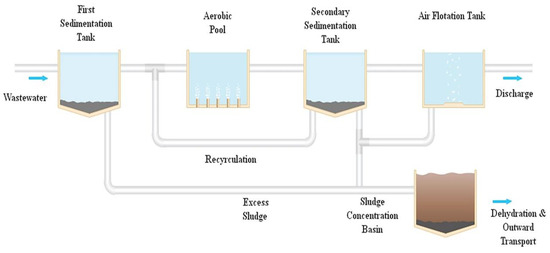
Figure 1.
Wastewater treatment system of straw pulp papermaking (WTSPP).
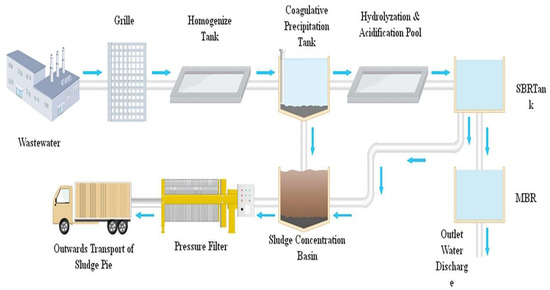
Figure 2.
Wastewater treatment system of printing and dyeing and papermaking (WTPDP).
According to the standard measurements [2], water samples from the treatment system inlet and outlet have been measured. The central monitoring indicators are chemical oxygen demand (COD), total oxygen demand (BOD), suspended solids (SS), total phosphorus, total nitrogen, ammonia nitrogen, etc. (shown in Table 1).

Table 1.
Sewage quality testing from inlet and outlet.
2.2. Primary Treatment Processes of WTSPP and WTPDP
Figure 1 and Figure 2 demonstrate the basic primary processes of standard wastewater treatment for WTSPP and WTPDP. In the WTSPP, five main treatment processes are displayed in Figure 1, including the first sedimentation tank, aerobic pool, secondary sedimentation tank, air flotation tank, and sludge concentration basin. Therein, the first sedimentation tank, aerobic pool, and the secondary sedimentation tank are the critical subsystems in the WTSPP.
Compared with WTSPP, WTPDP is more complex, which has eight components, which are grille, homogenize tank, coagulative precipitation tank, hydrolyzation and acidification pool, sedimentation bioreactor tank (SBRT) membrane bioreactor (MBR), sludge concentration basin and pressure filter, respectively. In the coagulative precipitation tank and hydrolyzation and acidification pool, chemical reactions are the most intense. Special attention should be paid to the input of material flow, energy flow, information flow and money flow in the WTSPP and WTPDP.
2.3. Two Emergy Diagrams of Standard Wastewater Treatment in the Papermaking Plant
The emergy diagrams of the WTSPP and WTPDP are shown in Figure 3 and Figure 4, which both include a renewable energy part (left part), a non-renewable resources part (upper part), outputs (left part), and core process subsystem (middle part). For WTSPP and WTPDP, a construction subsystem and an operation subsystem are necessary to keep the system working properly. Compared with two emergy diagrams, WTPDP demands more resources, energy, and economic and information inputs than WTSPP.
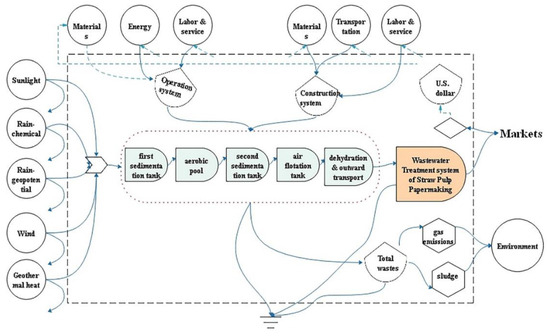
Figure 3.
Wastewater treatment system emergy diagram of straw pulp papermaking.
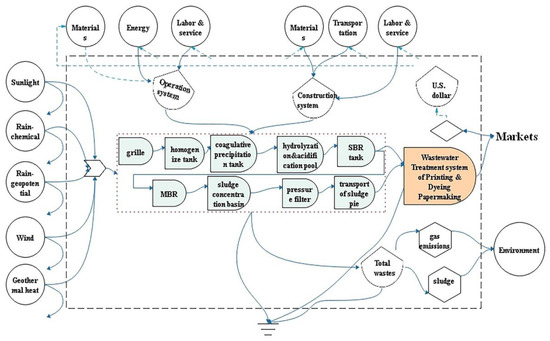
Figure 4.
Wastewater treatment system emergy diagram of printing and dyeing papermaking.
2.4. Wastewater Treatment Emergy Fundamental Calculated Process
As a comprehensive and complex system, the wastewater treatment emergy system contains energy, material, service, waste discharge, etc. The fundamental equation which can be used is shown in Equation (1):
where represents the basic emergy, is the transformity of input element, and is the number of inputs. On the basis of transformity and amount of all inputs, wastewater treatment system sustainability can be assessed. All subsystem details can be found as follows.
Generally speaking, there are four types of inputs in the wastewater treatment system, which are energy-emergy, material-emergy, service-emergy and waste-emergy.
2.4.1. Energy-Emergy Calculation
In the entire wastewater treatment system, energy-emergy is made up of renewable energy-emergy and product energy-emergy. Renewable energy-emergy has sunlight energy-emergy, rain chemical-emergy, rain geopotential-emergy, wind energy-emergy, geothermal energy-emergy, etc. Product energy-emergy includes coal emergy, electricity emergy, gasoline emergy, diesel emergy natural gas emergy, etc.
where represents the renewable energy input emergy. , , , and represent all renewable energy inputs transformities. , , , and are sunlight energy-emergy, rain chemical-emergy, rain geopotential-emergy, wind energy-emergy, and geothermal energy-emergy, respectively.
where represents nonrenewable energy input emergy and (, ), (, ), (, ), (, ), (, ) show all product energy-emergy, including coal emergy, electricity emergy, gasoline emergy, diesel emergy natural gas emergy, etc.
2.4.2. Material-Emergy Calculation
Material is an essential resource in the wastewater treatment system, and material emergy results can be computed by using Equation (4). In the calculated process, primary material emergy and auxiliary material emergy both need to be considered.
therein, represents material emergy, and (, ) and (, ) represent primary material emergy data and auxiliary material emergy data.
2.4.3. Service-Emergy Calculation
There are many different kinds of service- emergy in the wastewater treatment system, involving equipment, labor, tax, rental, repair, welfare benefits, wages, etc. It can be obtained by Equation (5):
where represents service emergy, and and are the amount and transformity of all service inputs in the wastewater treatment system.
2.4.4. Waste-Emergy Calculation
In the wastewater treatment system, there are three primary pollutants, containing exhaust gas, wastewater and solid waste, etc. Waste-emergy can be obtained by utilizing Equation (6):
where represents waste emergy and (, ), (, ) and (, ) are exhaust gas emergy, wastewater emergy, and solid waste emergy, respectively.
2.4.5. Structural Emergy Flow in the Wastewater Treatment System
In this evaluated framework of the wastewater treatment system, five inputs and outputs will be considered and assessed, as follows. The calculated equation and total necessary emergy data are shown in Equations (7) and (8), and in Table 2.

Table 2.
All emergy flow in the wastewater treatment system.
- (1)
- wastewater treatment input emergy: renewable energy-emergy, nonrenewable resource-emergy (material-emergy), nonrenewable energy-emergy (energy product emergy), service-emergy.
- (2)
- wastewater treatment output emergy: waste-emergy and main product emergy.
2.5. Wastewater System Emergy Indicators
In order to quantify the relationship between a wastewater treatment system and the environment, three emergy index groups have been put forward, including basic structure emergy indicators (BEI), functional emergy indicators (FEI) and eco-efficiency emergy indicators (EEI). BSEI represents the proportions of solar energy inputs inside the wastewater treatment system. FEI use functional requirements to assess the wastewater treatment system. The most critical indicator group is EEI, which displays the quantitative states of the wastewater treatment system and the external environment. On the basis of these index groups, the environmental sustainability of the wastewater treatment system can be estimated quantitatively, which integrates ecological, economic, and social benefits in the calculated result and provides a comprehensive reference. Figure 5 shows the relationship between BEI, FEI and EEI.
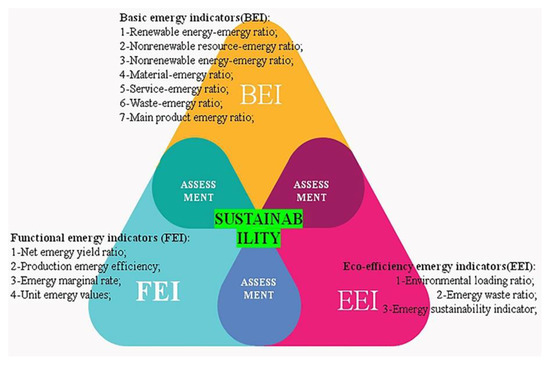
Figure 5.
Sustainability assessment based on BEI-FEI-EEI indicator groups. (basic emergy indicators – functional emergy indicators – eco-efficiency emergy indicators).
2.5.1. Basic Emergy Indicators
As the fundamental indicators, seven necessary emergy indexes have been listed in Table 3, involving renewable energy-emergy ratio, nonrenewable resource-emergy ratio, nonrenewable energy-emergy ratio, material-emergy ratio, service-emergy ratio, waste-emergy ratio and main product emergy ratio. All of these sub-indices are premise and foundation to compute functional emergy indicators (FEI) and eco-efficiency emergy indicators (EEI).

Table 3.
Basic structure emergy indicators.
2.5.2. Functional Emergy Indicators
Taking the market as the reference, functional emergy indicators indicate the resource efficiency of the wastewater treatment system, including net emergy yield ratio, production emergy efficiency, emergy marginal rate, unit emergy values, etc. All details of functional emergy indicators can be found in Table 4.

Table 4.
Fundamental emergy indicators.
- (1)
- Net emergy yield ratio (NEYR)
NEYR manifests the ratio between the produced emergy amount and input emergy; meanwhile, waste emergy will be excluded. It represents resources, energy and economic efficiency in the wastewater treatment system. The higher its value, the more competitive it is.
The equation can be expressed as Equation (9).
- (2)
- Production emergy efficiency (PEE)
PEE demonstrates the economic emergy efficiency and is the proportion of financial income on the basis of the main product emergy to total emergy in the wastewater treatment system. Equation (10) can be utilized to estimate PEE. Similar to NEYR, the greater PEE, the better the economy in evaluated system.
- (3)
- Emergy marginal rate (EMR)
EMR describes the change ratio between output emergy change and total emergy variation in the wastewater treatment system, which can be counted by Equation (11). It signifies the marginal emergy effect of the wastewater treatment system. The higher the index, the better the development trend.
- (4)
- Unit emergy values (UEVs)
UEVs reflect the efficiency of the entire wastewater treatment system and can be obtained through main production emergy to total inputs, including energy, resource, service, etc. It can be computed as Equation (12). Therefore, the lower the UEVs, the more profitable the wastewater treatment system.
2.5.3. Eco-Efficiency Emergy Indicators
Eco-efficiency emergy indicators include four types, which are environmental loading ratio, emergy waste ratio, and emergy sustainability indicator. All details of eco-efficiency emergy indicators are listed in Table 5. They represent the relationship between the environment wastewater treatment system.

Table 5.
Eco-efficiency emergy indicators.
- (1)
- Environmental loading ratio (ELR)
The ratio of non-renewable emergy to total emergy, EIR is defined; it can be used to elaborate on the ecological load of the wastewater treatment ecosystem. Several studies have already conducted a series of standards for various environmental load degrees [41], including low values (), medium intensity (), and high environmental load (). The calculation equation has been shown as follows:
- (2)
- Emergy waste ratio (EWR)
In general, waste is unavoidable in the wastewater treatment system and must be considered quantitatively. EWR can measure the quantitative waste impact on the basis of emergy term, as shown in Equation (14):
It reflects the efficiency of the wastewater treatment system. The higher the indicator, the lower of resource utilization.
- (3)
- Emergy sustainability indicator (ESI)
ESI demonstrates the ratio between EYR and ELR. It expresses the far-reaching effect of the environment in the wastewater treatment system. Generally speaking, based on the literature in [41], three standards were adopted to explain the sustainable status, which contains ESI , ESI and ESI in the long term. Equation (15) can be used:
ESI can manifest the overall effects of environment and wastewater treatment systems, involving economic, social, and environmental benefits, which illustrates the quantitative development in the wastewater treatment system.
3. Sustainability Assessment of Two Standard Wastewater Treatment system
3.1. Primary Emergy Table Calculation and Analysis
In Table 6, all emergy values of WTSPP have been calculated and listed, which shows a total evaluation quantitatively. Six main sections in the WTSPP demonstrate the contribution importance. According to the emergy proportion of WTSPP, nonrenewable resources emergy is the primary contributor and accounts for roughly 62.5%, much higher than other proportions. In addition, output emergy is 13.1%, followed by 11.9% of energy input emergy, 6.9% of wastewater treatment chemicals input emergy, 5.05% of service emergy and 0.49% of renewable emergy. As the second emergy proportion, the high output emergy ensures high efficiency of the WTSPP. Meanwhile, energy input emergy and wastewater treatment chemicals input emergy also play the essential function for sustainability of the WTSPP. Therein, the proportion of renewable energy is very small, which has little effect on the whole system.

Table 6.
Primary emergy calculation table of WTSPP.
Compared with Table 6 and Table 7 displays the WTPDP emergy distribution. Although the proportion is a little lower, nonrenewable resources emergy is also the most significant contributor in the entire emergy of WTPDP (53.7%). Energy emergy becomes the second most important factor, accounting for approximately 24.4% of the whole WTPDP emergy, much larger than WTSPP (about 11.9%). This is because WTPDP has a more complex wastewater treatment process than WTSPP, which needs more energy emergy input. Others’ emergy values contain output emergy (12.2%), wastewater treatment chemicals input emergy (4.87%), service emergy (4.54%) and renewable emergy (0.27%). The emergy structure distributions of WTSPP and WTPDP are shown in Figure 6.

Table 7.
Primary emergy calculation table of WTPDP.
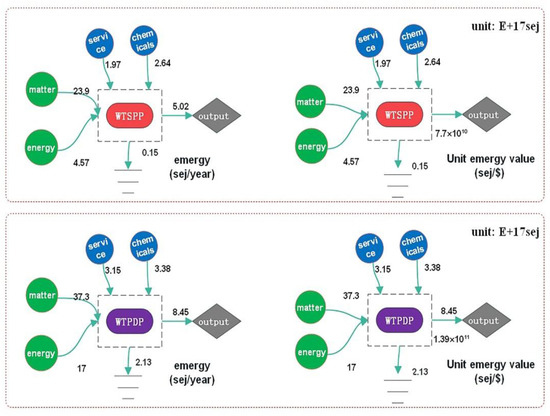
Figure 6.
Emergy structure distribution of WTSPP and WTPDP.
In general, nonrenewable resources emergy and energy input emergy both dominate input emergy in the WTSPP and WTPDP. They add up to 74.4% of WTSPP and 78.1% of WTPDP, respectively, which illustrate a considerable investment of non-renewable resources and energy in the WTSPP and WTPDP.
3.2. Entire Sustainability Indicators Analysis
In Table 8 and Figure 7, three leading sustainability indicators of WTSPP and WTPDP have been computed and listed, including basic emergy indicators, fundamental emergy indicators and eco-efficiency emergy indicators.

Table 8.
Entire emergy indicators analysis of WTSPP and WTPDP.
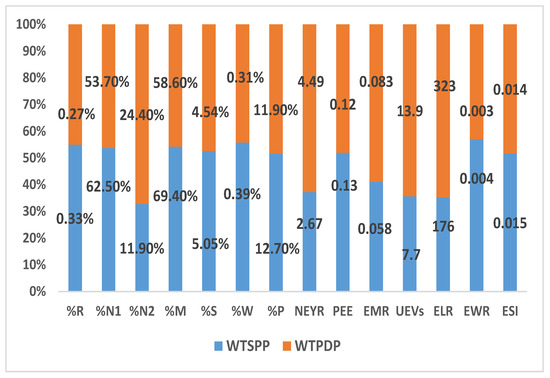
Figure 7.
Sustainability indicators comparison between WTSPP and WTPDP.
For basic emergy indicators, seven emergy indexes of WTSPP and WTPDP have been shown. Among them, comparing the data of WTSPP with WTPDP, nonrenewable resource-emergy ratio (%N1) and nonrenewable energy-emergy ratio (%N2) have apparent differences, which are 62.5% and 11.9% of WTSPP, and 53.7% and 24.4% of WTPDP, respectively.
Based on functional emergy indicators, WTPDP has a slightly higher net emergy yield ratio (NEYR) than WTSPP. Emergy marginal rate (EMR) of WTSPP and WTPDP has a similar trend, from 0.083 to 0.058. They have almost the same values of production emergy efficiency (PEE). According to unit emergy values (UEVs) in Figure 7, WTPDP is obviously higher than WTSPP, from 1.39 × 1011 sej/$ to 7.7 × 1010 sej/$ (approximately 1.81 times), which manifests more emergy input in WTPDP than in WTSPP.
As the important indicator group, eco-efficiency emergy indicators give the direct sustainability status about WTSPP with WTPDP. The environmental loading ratio (ELR) is 176 in the WTSPP and 323 in the WTPDP, respectively, demonstrating that the latter has higher environmental pressures than the former. Finally, emergy sustainability indicators (ESI) in the WTSPP with WTPDP, are nearly the same on the basis of the net emergy yield ratio (NEYR) to environmental loading ratio (ELR), which are 0.015 and 0.014, respectively.
Generally speaking, WTPDP has more of an environmental load than WTSPP, but also considering more net emergy yield ratio (NEYR) in WTPDP, their ratios (ESI) are almost equal.
4. Emergy Sustainability Information Analysis Based on the Neural Network Framework
4.1. Basic Neural Network Model of WTSPP and WTPDP
Figure 8 shows the basic network framework, including three sections, which are A1–A5 (inputs), B2–B5 (middle layer) and C1–C3 (outputs). Therein, A1–A5 represent renewable emergy, nonrenewable resources emergy, wastewater treatment chemicals input emergy, energy input emergy, and service emergy. B1–B5 express the essential process of WTSPP, containing the first sedimentation tank, aerobic pool, secondary sedimentation tank, air flotation tank and sludge concentration basin. C1–C3 are qualified water, exhaust gas, and sludge, respectively.
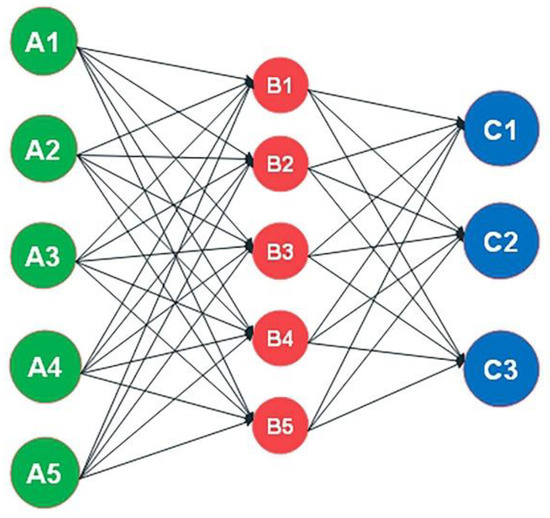
Figure 8.
Basic neural network analysis model of WTSPP.
In Figure 9, the basic neural network analysis model of WTPDP has been demonstrated. Similar to Figure 7, A1–A5 and C1–C3 have the same meanings. The differences are B1–B8 of WTPDP, including grille, homogenize tank, coagulative precipitation tank, hydrolyzation and acidification pool, SBRT tank, MBR, sludge concentration basin and pressure filter, respectively.
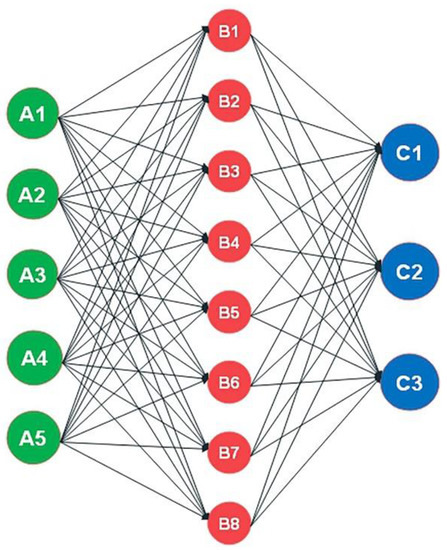
Figure 9.
Basic neural network analysis model of WTPDP.
Comparing Figure 10 and Figure 11 with Figure 8 and Figure 9, more detailed emergy inputs are taken into account in the neural network analysis model (in Table 6 and Table 7), which are sunlight (A1), rain-chemical (A2), rain geopotential (A3), wind energy (A4), geothermal energy (A5), cement (A6), steel (A7), gravel (A8), brick (A9), wood (A10), tap water (A11), limestone (A12), aluminum (A13), tile (A14), asphalt (A15), polyaluminium chloride (A16), Cl2 liquid (A17), polyacrylamide (A18), potassium permanganate (A19), electricity (A20), coal (A21), oil (A22), labor (A23), facilities maintenance (A24), transportation (A25), etc.
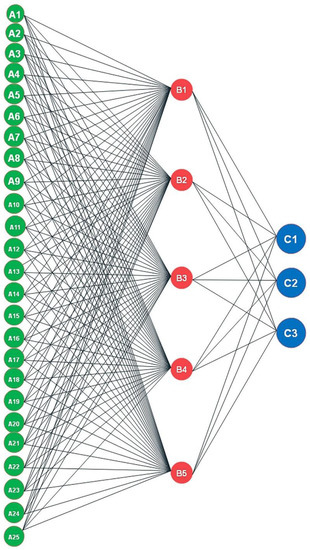
Figure 10.
Detailed neural network analysis model of WTSPP.
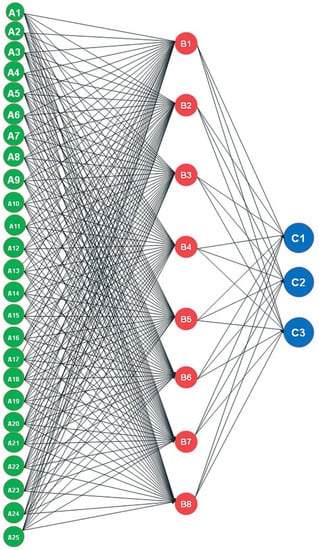
Figure 11.
Detailed neural network analysis model of WTPDP.
4.2. Neural Network Roadmaps of WTSPP and WTPDP
Figure 12 is the neural network diagram of WTSPP and WTPDP. For the WTSPP model, there are five routes to realize the sewage treatment function, more than WTPDP (only four routes). Based on Figure 12, all routes have been extracted for neural network analysis. Specific route information can be found in Table 9; Table 10, which are the basics of iterative computing.
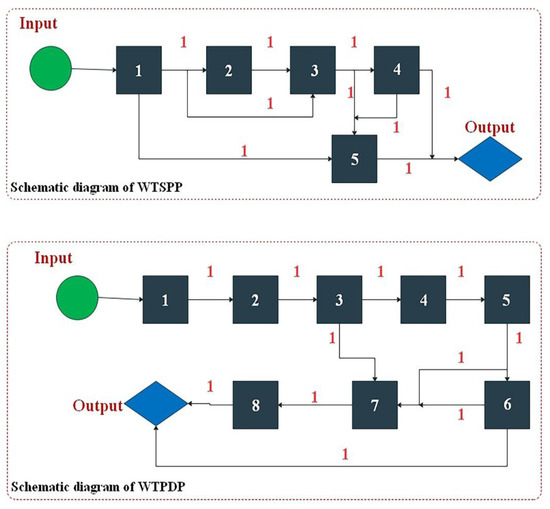
Figure 12.
Neural network routes of WTSPP and WTPDP.

Table 9.
Matrix data of the WTSPP route.

Table 10.
Matrix data of the WTPDP route.
4.3. Neural Network Iteration Path and Algorithm Operation Diagram of WTSPP and WTPDP
In Figure 13, Figure 14, Figure 15 and Figure 16, all iterative routes of WTSPP and WTPDP have been listed and displayed. Among them, the WTSPP model has five routes that are shown in Figure 13. Because it has only five processing steps to treat wastewater (refer to Figure 1), there are fewer iteration steps. Compared with WTSPP, the WTPDP model has eight processing steps (refer to Figure 2), and four primary routes have been revealed in Figure 14, Figure 15 and Figure 16.

Figure 13.
Neural network iterative computation route 1 to route 5 diagram of WTSPP.
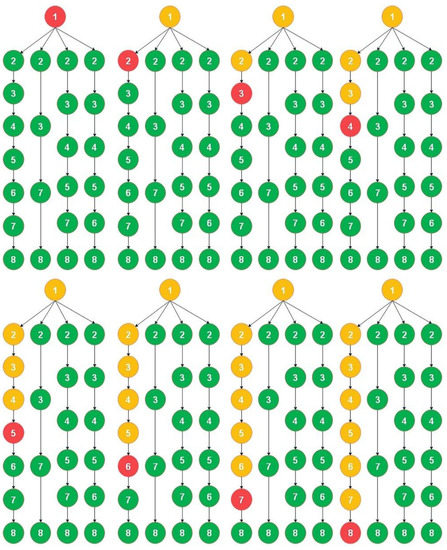
Figure 14.
Neural network iterative computation route 1 diagram of WTPDP.
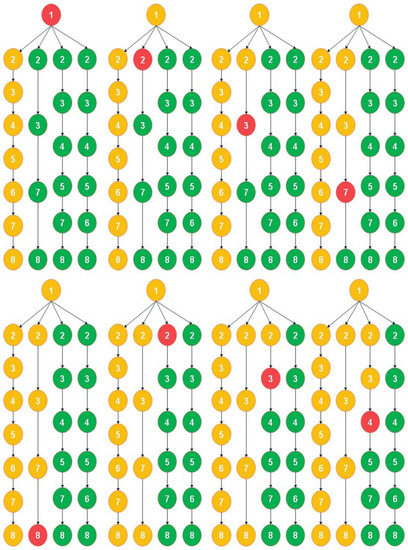
Figure 15.
Neural network iterative computation route 2 and route 3 diagram of WTPDP.
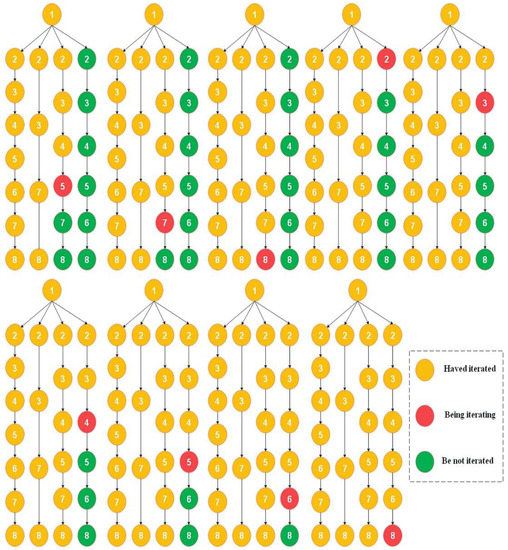
Figure 16.
Neural network iterative computation route 3 and route 4 diagram of WTPDP.
Figure 17 is the algorithm operation diagram of WTSPP and WTPDP on the basis of neural network methodology, which is the basis of neural network simulation.
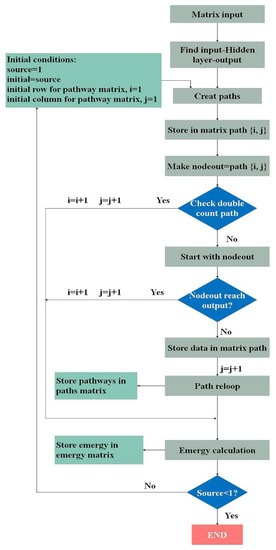
Figure 17.
Neural network algorithm operation diagram of WTSPP and WTPDP.
4.4. WTSPP and WTPDP Emergy Results Analysis Based on Neural Network
4.4.1. WTSPP and WTPDP Models Sustainability Indicators (ESI) Iterative Result Analysis
Figure 18 and Figure 19 are the overall calculation results of WTSPP and WTPDP based on MATLAB software simulations. For the WTSPP, the 45th step has the best validation performance about sustainability. Compared with this result, it only needs 63 steps to get the optimal outcome for WTPDP. In these two diagrams, three curves and two dotted lines have been shown, including the train curve, validation curve and test curve, best line and goal line, etc. In the early stage of iterative operation (Figure 18 and Figure 19), the three lines have apparent fluctuation and gradually, slowly approach the standard line, demonstrating that best validation performance appears.
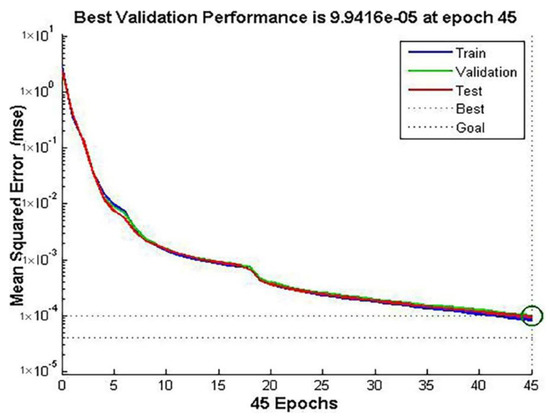
Figure 18.
Emergy sustainability indicators (ESI) iterative result analysis of WTSPP.
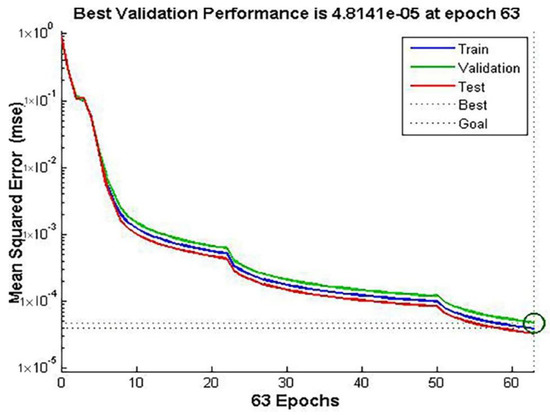
Figure 19.
Emergy sustainability indicators (ESI) iterative result analysis of WTPDP.
In addition, comparing WTSPP and WTPDP, the former obviously requires fewer steps than the latter, which illustrates WTSPP performance is better than WTPDP. In terms of sustainability considerations, WTSPP has more sustainability than WTPDP in the long run, and these results can be verified from Table 8.
4.4.2. WTSPP and WTPDP Models Sustainability Indicators (ESI) Data Regression Analysis
The predicted sustainability data regression processes of WTSPP and WTPDP are analyzed in Figure 20 and Figure 21. It is obvious that the WTSPP regression result is better than the WTPDP result. There are four regression parameters to manifest the comprehensive regression results by using the training regression parameter, the validation regression parameter, the test regression parameter, all other regression parameters, etc. In Figure 20 (for WTSPP), four parameters are 0.99991, 0.99988, 0.9999 and 0.9999, respectively; meanwhile for WTPDP (in Figure 21), the corresponding data are 0.96292, 0.89944, 0.91966 and 0.94322, respectively. On the basis of regression effects, a similar conclusion can be drawn that WTSPP is more sustainable than WTPDP in the long run.
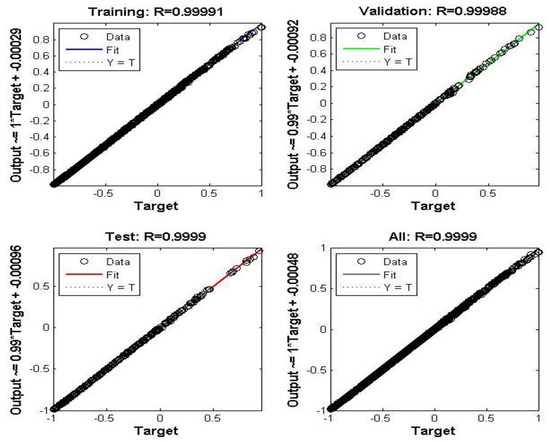
Figure 20.
Emergy sustainability indicators (ESI) data regression analysis of WTSPP.
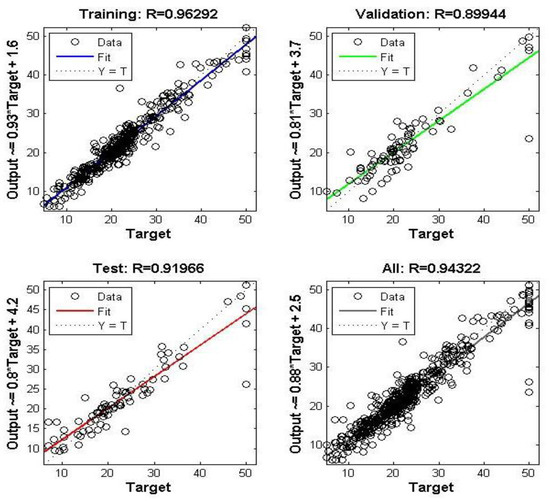
Figure 21.
Emergy sustainability indicators (ESI) data regression analysis of WTPDP.
4.4.3. WTSPP and WTPDP Models Sustainability Indicators (ESI) Error Analysis
Through MATLAB simulation, the errors of all predictive sustainability indicators have been calculated and are shown in Figure 22 and Figure 23. Depending on fluctuation degrees, WTSPP is better than WTPDP. The maximum fluctuation ranges of WTSPP and WTPDP are (3%, −27%) and (28%, 61%), respectively. This is because the process flow of WTSPP is longer than that of WTPDP, resulting in more negative factors and more iterations. Given Figure 1 and Figure 2, WTSPP has five primary processes for wastewater treatment, but WTPDP has eight main subsystems, leading to the bigger errors in the long run.

Figure 22.
Emergy sustainability indicators (ESI) error analysis of WTSPP.
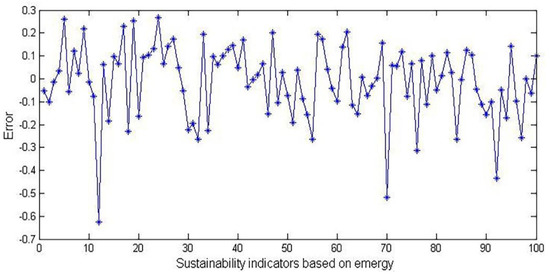
Figure 23.
Emergy sustainability indicators (ESI) error analysis of WTPDP.
5. Conclusions
In this paper, the sustainability of two standard wastewater treatment systems (WTSPP and WTPDP) was considered and analyzed on the basis of the hybrid neural network and emergy framework. For WTSPP and WTPDP, the parameters after sewage treatment meet the national standard [2]. On this basis, the research of this paper is carried out. Firstly, the fundamental emergy analysis has been executed by using three types of indicators, including basic structure emergy indicators (BEI), functional emergy indicators (FEI) and eco-efficiency emergy indicators (EEI). According to the preliminary calculations and analysis of WTSPP and WTPDP, the hybrid investigations based on the neural network-emergy framework have been conducted. Through the basic neural network model and detailed neural network model design, the iteration paths and algorithm operation diagram of WTSPP and WTPDP have been designed and realized in this article, resulting in sustainability prediction of WTSPP and WTPDP in the long run.
The main conclusions are summarized as follows.
- (1)
- For WTSPP, nonrenewable resources emergy is the primary contributor and accounts for roughly 62.5%, much higher than other proportions. In addition, output emergy is 13.1%, followed by 11.9% of energy input emergy, 6.9% of wastewater treatment chemicals input emergy, 5.05% of service emergy and 0.49% of renewable emergy.
- (2)
- For WTPDP, nonrenewable resources emergy is also the most significant contributor in the entire emergy of WTPDP (53.7%). Energy emergy becomes the second most important factor, accounting for approximately 24.4% of the whole WTPDP emergy, much larger than WTSPP (about 11.9%).
- (3)
- As the vital indicator group, the environmental loading ratio (ELR) is 176 in the WTSPP and 323 in the WTPDP, respectively. Emergy sustainability indicators (ESIs) in the WTSPP and WTPDP, are 0.015 and 0.014, respectively.
- (4)
- Comprehensive calculation results of WTSPP and WTPDP have been conducted based on MATLAB software simulations.
- (5)
- For the WTSPP, the 45th step has the best validation performance about sustainability. Compared with this result, it only needs 63 steps to get the optimal outcome for WTPDP.
- (6)
- For WTSPP, four regression parameters of are 0.99991, 0.99988, 0.9999 and 0.9999, respectively; meanwhile for WTPDP (in Figure 21), the corresponding data are 0.96292, 0.89944, 0.91966 and 0.94322, respectively.
- (7)
- Depending on fluctuation degrees, WTSPP is better than WTPDP. The maximum fluctuation ranges of WTSPP and WTPDP are (3%, −27%) and (28%, 61%), respectively.
- (8)
- All neural network analysis results manifest that emergy sustainability indicators (ESIs) of WTSPP and WTPDP are [0.0151, 0.011] and [0.0179, 0.0055] in view of a long-term predictive view, respectively.
Through this study, some points can be obtained by international scientists. For example, under the premise of ensuring the sewage treatment quality, the sustainability of the whole system is related to the process complexity of wastewater treatment. The more complex the process, the worse the sustainability, and the higher the error in the long term. Therefore, in a sewage treatment system, it is necessary to consider not only the quality after treated sewage but also the complexity of the whole process. Only by balancing the quality of treated wastewater, and the complexity of the system, can the sustainable development of a sewage treatment system be realized.
Author Contributions
Conceptualization, J.Z.; investigation, Y.Y.; formal analysis, L.M.; methodology, J.Z.; resources, J.Z.; writing—review and editing, J.Z. All authors have read and agreed to the published version of the manuscript.
Funding
The work described in this paper was supported by the Postgraduate Research & Practice Innovation Program of Jiangsu Province (KYCX18_0104).
Conflicts of Interest
The authors declare no conflict of interest.
Appendix A
- 1-Sunlight energy = plant area (2 × 105 m2) × avg. annual solar radiation (5.01 × 109 J/m2) × albedo (0.13). UEVs of sunlight = 1.00 sej/J by definition. Sunlight emergy = 1.3 × 1014 sej.
- 2-Rain chemical potential energy = plant area (2 × 105 m2) × annual rainfall (0.59 m) × evaporation rate (60.0%) × water density(1000 kg/m3) × Gibbs free energy (4.94 × 103 kJ/kg); UEV = 2.35 × 104 sej/J [43]. Rain chemical potential emergy = 3.5 × 1010 × 2.35 × 104 = 8.24 × 1015 sej.
- 3-Rain geopotential energy = plant area (2 × 105 m2) × annual rainfall (0.59 m) × runoff rate (40%) × water density (1000 kg/m3) × average elevation (4 m) × gravity (9.8 m/s2); UEV = 2.79 × 104 sej/J [43]. Rain geopotential emergy = 1.85 × 108 × 2.79 × 104 sej = 5.16 × 1013 sej.
- 4-Wind kinetic energy= plant area (2 × 105 m2) × air density (1.29 kg/m3) × drag coefficient (0.001) × velocity of geostrophic wind3(27) × (3.15 × 107 s/year). UEV = 1.9 × 103 sej/J [43]. Wind kinetic emergy = 2.2 × 1010 × 1.9 × 103sej = 4.18 × 1014 sej.
- 5-Geothermal energy = plant area (2 × 105 m2) × heat flow (1.45 × 106 J/(M2*year). UEV =3.44 × 104 sej/J [44]. Geothermal emergy = 2.9 × 1010 × 3.44 × 104 sej = 9.98 × 1015 sej.
References
- China Environmental Statistics Annual Report. 2015. Available online: http://www.mee.gov.cn/hjzl/sthjzk/sthjtjnb/ (accessed on 15 January 2020).
- Discharge Standard of Pollutants for Municipal Wastewater Treatment Plant (National Standard GB 18918-2002). Available online: http://www.fao.org/faolex/results/details/en/c/LEX-FAOC136765/ (accessed on 23 June 2020).
- Liu, K.; Lin, B. Research on influencing factors of environmental pollution in China: A spatial econometric analysis. J. Clean. Prod. 2019, 206, 356–364. [Google Scholar] [CrossRef]
- Zhou, W.; Chen, L.; Feng, L. Effectiveness evaluation on third-party governance model for environmental pollution in China. Environ. Sci. Pollut. Res. 2019, 26, 17305–17320. [Google Scholar] [CrossRef] [PubMed]
- Pazda, M.; Kumirska, J.; Stepnowski, P.; Mulkiewicz, E. Antibiotic resistance genes identified in wastewater treatment plant Systems-A review. Sci. Total Environ. 2019, 697, 134023. [Google Scholar] [CrossRef] [PubMed]
- Nannou, C.; Ofrydopoulou, A.; Evgenidou, E.; Heath, D.; Heath, E.; Lambropoulou, D. Antiviral drugs in aquatic environment and wastewater treatment plants: A review on occurrence, fate, removal and ecotoxicity. Sci. Total Environ. 2020, 699, 134322. [Google Scholar] [CrossRef] [PubMed]
- Zheng, W.; Huyan, J.; Tian, Z.; Zhang, Y.; Wen, X. Clinical class 1 integron-integrase gene-A promising indicator to monitor the abundance and elimination of antibiotic resistance genes in an urban wastewater treatment plant. Environ. Int. 2020, 135, 105372. [Google Scholar] [CrossRef]
- Solé-Bundó, M.; Garfí, M.; Ferrer, I. Pretreatment and co-digestion of microalgae, sludge and fat oil and grease (FOG) from microalgae-based wastewater treatment plants. Bioresour. Technol. 2020, 298, 122563. [Google Scholar] [CrossRef]
- Teoh, S.K.; Li, L.Y. Feasibility of alternative sewage sludge treatment methods from a lifecycle assessment (LCA) perspective. J. Clean. Prod. 2020, 247, 119495. [Google Scholar] [CrossRef]
- Grönlund, S.E. Indicators and methods to assess sustainability of wastewater sludge management in the perspective of two systems ecology models. Ecol. Indic. 2019, 100, 45–54. [Google Scholar] [CrossRef]
- Zhang, X.; Cao, J.; Li, J.; Deng, S.; Zhang, Y.; Wu, J. Influence of sewage treatment on China’s energy consumption and economy and its performances. Renew. Sustain. Energy Rev. 2015, 49, 1009–1018. [Google Scholar] [CrossRef]
- Yang, J.; Liu, X.; Ying, L.; Chen, X.; Li, M. Correlation analysis of environmental treatment, sewage treatment and water supply efficiency in China. Sci. Total Environ. 2020, 708, 135128. [Google Scholar] [CrossRef]
- Nolte, T.M.; Chen, G.; van Schayk, C.S.; Pinto-Gil, K.; Jan Hendriks, A.; Peijnenburg, W.J.G.M.; Ragas, A.M. Ragas. Disentanglement of the chemical, physical, and biological processes aids the development of quantitative structure-biodegradation relationships for aerobic wastewater treatment. Sci. Total Environ. 2020, 708, 133863. [Google Scholar] [CrossRef] [PubMed]
- Zhang, Z.; Chen, Y. Effects of microplastics on wastewater and sewage sludge treatment and their removal: A review. Chem. Eng. J. 2020, 382, 122955. [Google Scholar] [CrossRef]
- Morera, S.; Santana, M.V.E.; Comas, J.; Rigola, M.; Corominas, L. Evaluation of different practices to estimate construction inventories for life cycle assessment of small to medium wastewater treatment plants. J. Clean. Prod. 2020, 245, 118768. [Google Scholar] [CrossRef]
- Nakatsuka, N.; Kishita, Y.; Kurafuchi, T.; Akamatsu, F. Integrating wastewater treatment and incineration plants for energy efficient urban biomass utilization: A life cycle analysis. J. Clean. Prod. 2020, 243, 118448. [Google Scholar] [CrossRef]
- Xu, Y.; Naidoo, A.R.; Zhang, X.; Meng, X.Z. Optimizing sampling strategy for Chinese National Sewage Sludge Survey (CNSSS) based on urban agglomeration, wastewater treatment process, and treatment capacity. Sci. Total Environ. 2019, 696, 133998. [Google Scholar] [CrossRef]
- Brunsch, A.F.; Florez, P.Z.; Langenhoff, A.A.M.; Laak, T.L.t.; Rijnaarts, H.H.M. Retention soil filters for the treatment of sewage treatment plant effluent and combined sewer overflow. Sci. Total Environ. 2020, 699, 134426. [Google Scholar] [CrossRef]
- Laura, F.; Tamara, A.; Müller, A.; Hiroshan, H.; Christina, D.; Serena, C. Selecting sustainable sewage sludge reuse options through a systematic assessment framework: Methodology and case study in Latin America. J. Clean. Prod. 2020, 242, 118389. [Google Scholar] [CrossRef]
- Odum, H.T. Environmental Accounting. In Emergy and Environmental Decision Making; John Wiley Sons, INC.: Hoboken, NJ, USA, 1996; Volume 370. [Google Scholar] [CrossRef]
- Zhao, H.; Zhai, X.; Guo, L.; Liu, K.; Huang, D.; Yang, Y.; Li, J.; Xie, S.; Zhang, C.; Tang, S.; et al. Assessing the efficiency and sustainability of wheat production systems in different climate zones in China using emergy analysis. J. Clean. Prod. 2019, 235, 724–732. [Google Scholar] [CrossRef]
- Zhang, X.; Zhang, R.; Wu, J.; Zhang, Y.Z.; Lin, L.; Deng, S.; Li, L.; Yang, G.; Yu, X.; Qi, H.; et al. An emergy evaluation of the sustainability of Chinese crop production system during 2000–2010. Ecol. Indic. 2016, 60, 622–633. [Google Scholar] [CrossRef]
- Pan, H.; Zhuang, M.; Geng, Y.; Wu, F.; Dong, H. Emergy-based ecological footprint analysis for a mega-city: The dynamic changes of Shanghai. J. Clean. Prod. 2019, 210, 552–562. [Google Scholar] [CrossRef]
- Chen, W.; Zhong, S.; Geng, Y.; Chen, Y.; Cui, X.; Wu, Q.; Pan, H.; Wu, R.; Sun, L.; Tian, X. Emergy based sustainability evaluation for Yunnan Province, China. J. Clean. Prod. 2017, 162, 1388–1397. [Google Scholar] [CrossRef]
- Srinivasan, R.S.; Braham, W.W.; Campbell, D.E.; Curcija, C.D. Re (De) fining Net Zero Energy: Renewable Emergy Balance in environmental building design. Build. Environ. 2012, 47, 300–315. [Google Scholar] [CrossRef]
- Luo, Z.; Zhao, J.; Yao, R.; Shu, Z. Emergy-based sustainability assessment of different energy options for green buildings. Energy Convers. Manag. 2015, 100, 97–102. [Google Scholar] [CrossRef]
- Liu, C.; Cai, W.; Dinolov, O.; Zhang, C.; Rao, W.; Jia, S.; Li, L.; Chan, F.T.S. Emergy based sustainability evaluation of remanufacturing machining Systems. Energy 2018, 150, 670–680. [Google Scholar] [CrossRef]
- Zhang, X.; Shen, J.; Wang, Y.; Qi, Y.; Liao, W.; Shui, W.; Li, L.; Qi, H.; Yu, X. An environmental sustainability assessment of China’s cement industry based on emergy. Ecol. Indic. 2017, 72, 452–458. [Google Scholar] [CrossRef]
- Yu, X.; Geng, Y.; Dong, H.; Fujita, T.; Liu, Z. Emergy-based sustainability assessment on natural resource utilization in 30 Chinese provinces. J. Clean. Prod. 2016, 133, 18–27. [Google Scholar] [CrossRef]
- Zhang, J.; Ma, L. Environmental Sustainability Assessment of a New Sewage Treatment Plant in China Based on Infrastructure Construction and Operation Phases Emergy Analysis. Water 2020, 12, 484. [Google Scholar] [CrossRef]
- Tian, X.; Geng, Y.; Ulgiati, S. An emergy and decomposition assessment of China-Japan trade: Driving forces and environmental imbalance. J. Clean. Prod. 2017, 141, 359–369. [Google Scholar] [CrossRef]
- Qi, Y.; Zhang, X.; Yang, X.; Lv, Y.; Wu, J.; Lin, L.; Xiao, Y.; Qi, H.; Yu, X.; Zhang, Y. The environmental sustainability evaluation of an urban tap water treatment plant based on emergy. Ecol. Indic. 2018, 94, 28–38. [Google Scholar] [CrossRef]
- Zhang, X.; Deng, S.; Wu, J.; Jiang, W. A sustainability analysis of a municipal sewage treatment ecosystem based on emergy. Ecol. Eng. 2010, 36, 685–696. [Google Scholar] [CrossRef]
- Shao, S.; Mu, H.; Yang, F.; Zhang, Y.; Li, J. Application of Emergy Analysis to the Sustainability Evaluation of Municipal Wastewater Treatment Plants. Sustainability 2017, 9, 8. [Google Scholar] [CrossRef]
- Yue, J.; Jiang, X.; Yuan, X.; Wang, X.; Li, B.; Liu, S. Design of a multiplexed system for domestic wastewater of Happy Farmer’s Home (HFH) and environmental evaluation using the emergy Analysis. J. Clean. Prod. 2017, 156, 729–740. [Google Scholar] [CrossRef]
- Londoño, N.A.C.; Suárez, D.G.; Velásquez, H.I.; Ruiz-Mercado, G.J. Emergy analysis for the sustainable utilization of biosolids generated in a municipal wastewater treatment plant. J. Clean. Prod. 2017, 141, 182–193. [Google Scholar] [CrossRef] [PubMed]
- Grönlund, E.; Billgren, C.; Tonderski, K.S.; Raburu, P.O. Emergy Assessment of a Wastewater Treatment Pond System in the Lake Victoria Basin. J. Environ. Account. Manag. 2017, 5, 11–26. [Google Scholar] [CrossRef]
- Vassallo, P.; Paoli, C.; Fabiano, M. Emergy required for the complete treatment of municipal Wastewater. Ecol. Eng. 2009, 35, 687–694. [Google Scholar] [CrossRef]
- Yang, L.; Kong, F.; Xi, M.; Li, Y.; Wang, S. Environmental economic value calculation and sustainability assessment for constructed rapid infiltration system based on emergy analysis. J. Clean. Prod. 2017, 167, 582–588. [Google Scholar] [CrossRef]
- Zhang, X.; Wei, Y.; Pan, H.; Xiao, H.; Wu, J.; Zhang, Y. The comparison of performances of a sewage treatment system before and after implementing the cleaner production measure. J. Clean. Prod. 2015, 91, 216–228. [Google Scholar] [CrossRef]
- Cao, C.; Feng, X. Distribution of emergy indices and its application. Energy Fuels 2007, 21, 1717–1723. [Google Scholar] [CrossRef]
- Odum, H.T. Self-Organization, Transformity, and Information. Science 1988, 242, 1132–1139. [Google Scholar] [CrossRef]
- Lee, J.M.; Braham, W.W. Building emergy analysis of Manhattan: Density parameters forhigh-density and high-rise developments. Ecol. Model. 2017, 363, 157–171. [Google Scholar] [CrossRef]
- Brown, M.T.; Bardi, E. Handbook of Emergy Evaluation: A Compendium of Data for Emergy Computation in a Series of Folios, Folio #3 Emergy of Ecosystem; Center for Environmental Policy, University of Florida: Gainesville, FL, USA, 2001. [Google Scholar]
- Chen, W.; Liu, W.; Geng, Y.; Ohnishi, S.; Sun, L.; Han, W.; Tian, X.; Zhong, S. Life cycle based emergy analysis on China’s cement production. J. Clean. Prod. 2016, 131, 272–279. [Google Scholar] [CrossRef]
- Pan, H.; Zhang, X.; Wu, J.; Zhang, Y.; Lin, L.; Yang, G.; Deng, S.; Li, L.; Yu, X.; Qi, H.; et al. Sustainability evaluation of a steel production system in China based on emergy. J. Clean. Prod. 2016, 112, 1498–1509. [Google Scholar] [CrossRef]
- Buranakarn, V. Evaluation of Recycling and Reuse of Building Materials Using the Emergy Analysis Method. 1998. Ph.D. Thesis, University of Florida, Gainesville, FL, USA, 1998. [Google Scholar]
- Cabezas, H.D.; Campbell, D.; Eason, T.; Garmestani, A.S.; Heberling, M.T.; Hopton, M.E.; Templeton, J.; White, D.; Zanowick, M. San Luis Basin Sustainability Metrics Project: A Methodology for Evaluating Regional Sustainability; Heberling, M.T., Hopton, M.E., Eds.; United States Environmental Protection Agency (US EPA): Washington, DC, USA, 2010; pp. 119–136.
- Liu, C.; Cai, W.; Jia, S.; Zhang, M.; Guo, H.; Hu, L.; Jiang, Z. Emergy-based evaluation and improvement for sustainable manufacturing systems considering resource efficiency and environment performance. Energy Convers. Manag. 2018, 177, 176–189. [Google Scholar] [CrossRef]
- Lou, B.; Ulgiati, S. Identifying the environmental support and constraints to the Chinese economic growth—An application of the Emergy Accounting method. Energy Policy 2013, 55, 217–233. [Google Scholar] [CrossRef]
- Brown, M.T.; Campbell, D.E.; de Vilbiss, C.; Ulgiati, S. The geobiosphere emergy baseline: A synthesis. Ecol. Model. 2016, 339, 92–95. [Google Scholar] [CrossRef]
© 2020 by the authors. Licensee MDPI, Basel, Switzerland. This article is an open access article distributed under the terms and conditions of the Creative Commons Attribution (CC BY) license (http://creativecommons.org/licenses/by/4.0/).